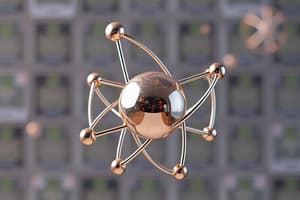Podcast
Questions and Answers
What defines the atomic number of an element?
What defines the atomic number of an element?
- The weighted average mass of the isotopes of the element
- The total number of protons in one atom of the element (correct)
- The total number of neutrons in the element
- The total number of electrons present in the element
Which statement correctly describes an isotope?
Which statement correctly describes an isotope?
- An atom that has the same number of electrons as neutrons
- An atom with an equal number of protons and neutrons
- An atom that has the same atomic number but different mass number (correct)
- An atom that always behaves as a metal
What is the mass number of an atom determined by?
What is the mass number of an atom determined by?
- The sum of the number of protons and neutrons in its nucleus (correct)
- The average mass of all isotopes of the element
- The total number of electrons in the atom
- The number of protons only
What distinguishes metals from nonmetals based on their properties?
What distinguishes metals from nonmetals based on their properties?
What does a group in the periodic table refer to?
What does a group in the periodic table refer to?
Match the following definitions with their corresponding terms:
Match the following definitions with their corresponding terms:
Match the following terms with their characteristics:
Match the following terms with their characteristics:
Match the following terms with their associated concepts:
Match the following terms with their associated concepts:
Match the following particles with their properties:
Match the following particles with their properties:
Match the following terms with their functions in atomic structure:
Match the following terms with their functions in atomic structure:
Flashcards are hidden until you start studying
Study Notes
Atomic Structure
- Atomic number: Represents the number of protons within an atom of a specific element, defining its identity.
- Atomic weight: The average mass of the isotopes of an element, factoring in their relative abundance.
- Electron: A negatively charged subatomic particle orbiting the atom's nucleus.
- Isotope: Atoms of the same element, possessing the same atomic number (same number of protons) but vary in the number of neutrons, thus differing in atomic weight.
- Mass number: The total number of protons and neutrons combined within an atom's nucleus.
- Neutron: A neutral subatomic particle residing within the nucleus of an atom.
- Nucleus: The central core of an atom, housing both protons and neutrons.
- Proton: A positively charged subatomic particle located within the atom's nucleus.
Periodic Table Organization
- Group: A vertical column of elements in the periodic table sharing similar chemical properties due to the same number of valence electrons.
- Metal: Characterized by properties like hardness, shininess, malleability (can be hammered into thin sheets), ductility (can be drawn into wires), and excellent conductivity of heat and electricity.
- Nonmetal: Exhibits contrasting properties to metals, often being soft, non-malleable, non-ductile, and poor conductors of heat and electricity.
- Period: A horizontal row of elements in the periodic table arranged by increasing atomic number, showcasing a recurring pattern of physical and chemical properties.
- Periodic table: A structured arrangement of elements organized by increasing atomic number, revealing a repeating pattern of physical and chemical properties.
Atomic Structure
- Atomic number defines the identity of an element.
- Protons are positively charged particles located in the nucleus of an atom.
- Neutrons have no charge and are found in the atom's nucleus.
- Mass number is the total number of protons and neutrons in an atom.
- Electrons are negatively charged subatomic particles that orbit the nucleus.
- Isotopes are atoms of the same element but have different numbers of neutrons, resulting in different mass numbers.
- Atomic weight represents the average mass of an element's isotopes, considering their relative abundance.
Periodic Table
- The periodic table organizes elements based on their atomic number, revealing recurring patterns in their chemical and physical properties.
- Periods are horizontal rows in the periodic table, indicating the number of electron shells in an atom.
- Groups are vertical columns in the periodic table, representing elements with similar chemical properties due to the same number of valence electrons.
Element Classification
- Metals generally exhibit properties like hardness, shininess, malleability, ductility, and good conductivity of heat and electricity.
- Nonmetals are typically soft, non-malleable, brittle, and poor conductors of heat and electricity.
Studying That Suits You
Use AI to generate personalized quizzes and flashcards to suit your learning preferences.




